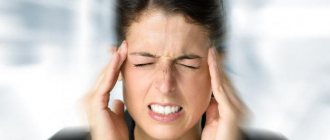Migraines are regular attacks of headache. In most cases, migraine pain affects either the left or right hemisphere, which is why this disease is sometimes also called hymicrania, which is translated from Greek as half the head.
During migraine attacks, periods of pain can last several days. Such prolonged attacks are called status migraine .
Migraine status is very difficult, it knocks a person out of the usual rhythm of life, makes him nervous, tired and irritable. Migrainous status can lead to prolonged depression.
Reasons for development
The causes of migraine have not yet been precisely determined - according to the results of diagnostic studies, patients do not find any injuries, tumors, glaucoma, or hypertension.
Therefore, migraine is classified as an “exception” pathology - the diagnosis is made by a specialist based on characteristic complaints and clinical manifestations. A migraine attack can begin suddenly - literally in 10-15 seconds its symptoms intensify many times: a person is unable to fulfill work obligations, takes a forced position in order to wait out the peak of pain.
Migraine manifestations can be triggered by a severe stressful situation, physical stress, psycho-emotional stress, or consumption of prohibited products, for example, alcohol, coffee, chocolate.
These are all external causes of migraine in adults. At the moment, specialists are conducting many studies aimed at identifying and eliminating internal causes, for example, the activity of the hypothalamus. It is this structure of the brain that bears the main burden of regulating internal reactions to external stimuli and controlling vascular tone.
Causes and risk factors
The exact cause of migraine has not yet been determined. It appears that migraines may be caused in part by changes in the levels of serotonin (one of the main neurotransmitters) in the body. Serotonin plays many roles in the body and can affect blood vessels because... When serotonin levels are high, blood vessels narrow (contract). When serotonin levels drop, blood vessels dilate (swell), which can cause pain or other problems.
What can trigger a migraine?
There are some risk factors that can trigger a migraine attack. Common risk factors include:
- Heredity . If one or both of your parents had migraines, there is a good chance that you will also experience the condition.
- Floor . Women suffer from migraines more often than men.
- Age . Most people first experience migraines during their teenage years, but the condition can actually begin at any age, typically before the age of 40.
The most common triggers for a migraine attack are:
- Food and drinks . Eating certain foods and drinks (see list below) can lead to migraines. Dehydration and dieting or skipping meals can also trigger migraines.
- Hormonal changes . Women may experience migraines related to their menstrual cycles, menopause, use of hormonal contraceptives, or hormone replacement therapy (see Menstrual Migraine - Headaches in Women).
- Stress . Stressful situations and nervous tension can cause migraines. Your nervous system may be overloaded by stressful situations at work or at home, and your body may be exhausted from intense training (in sports) or chronic lack of sleep.
- Feel . Loud noises, bright lights (flashing lights or sunlight), or strong odors (such as paint fumes) can trigger migraines.
- Medicines . Some medications can trigger migraines. If you think your migraine attacks may be related to the medications you are taking, talk to your doctor about it. Your doctor may suggest an alternative medicine.
- Disease . Infectious diseases such as colds or flu can also trigger migraines, especially in children (see Headache - Diseases).
Eating cheese and nuts can trigger a migraine
. Foods that can cause migraines:
- not fresh canned food, dried or otherwise prepared meat, sausages, herring
- not fresh cheese
- alcoholic drinks, especially red wine
- aspartame (sugar substitute)
- avocado
- beans
- brewer's yeast and bread starters
- caffeine (if consumed in excess)
- canned soups, instant soups, or bouillon cubes
- chocolate and cocoa
- fermented milk products such as buttermilk and sour cream
- figs
- lentils
- chops
- monosodium glutamate (E621)
- nuts and nut butter
- onions (in small quantities does not cause migraines)
- papaya
- passion fruit
- peas
- pickles, pickled canned foods such as olives and pickles, and some snacks
- raisin
- red plums
- sauerkraut
- snow peas
- soy sauce
At-risk groups
Experts identify the following risk groups for migraine:
- residents of large cities – where the level of stressful situations is several times higher;
- symptoms of pathology are more often detected in ambitious people trying to climb to the highest possible level of career growth;
- people with severe emotional instability, prone to depression;
- patients who, due to circumstances, are forced to take medications from certain subgroups for a long period of time, for example, sugar-lowering drugs, estrogens;
- those who abuse alcohol and tobacco products and lead a sedentary lifestyle;
- babies whose parents both complain of migraine attacks;
- Migraine in adolescents is quite possible at the time of rapid hormonal changes; over time, the child may well “outgrow” it.
Having identified individual symptoms or signs of pathology, it is recommended to consult a neurologist and conduct a comprehensive diagnostic examination.
In teenagers
Teenage migraines tend to run in families. Hormonal changes in a child increase the likelihood of developing migraine headaches. During this period, you should not burden your son or daughter with studies, because mental stress can lead to nervous breakdowns, and this, in turn, will negatively affect the developing organism.
Migraine attacks sometimes appear in adolescents due to the unfavorable emotional atmosphere that develops within the family. It is important to calm the child and help relieve tension.
Symptoms
Migraine attacks are chronic and cannot always be managed at home.
Its symptoms are diagnosed in people of different age categories, but representatives of the fair part of the population suffer more often. In children, migraine symptoms are detected in 6-8% of cases. The infant form is extremely rare. Main symptoms of the pathology:
- frequent urge to feel sick;
- at the peak of pain, vomiting occurs, bringing virtually no relief;
- severe photophobia;
- inappropriate reaction to loud sounds.
A migraine attack occurs against the background of a sudden expansion of a section of an intracranial vessel. After the vascular structures reach certain parameters, they begin to put pressure on nearby nerve endings. The reasons are quite simple, but the nature of their occurrence has not been fully studied by specialists - the same negative factor does not always provoke a deterioration in well-being.
Signs of migraine in adults rarely cause concern among specialists, since the pathology does not pose a direct threat to human life. It is quite possible to cope with mild and moderate attacks at home - the pain subsides after taking the remedies recommended by a specialist and staying in a darkened room in silence.
Severe, frequently recurring pain in the head - 3-5 times a month, without adequate therapeutic measures, may well become the cause of psychosomatic disorders.
How does a migraine attack occur?
Doctors distinguish 5 stages of exacerbation of the disease.
Phases of a migraine attack:
- Prodromal (initial). Signs of this stage are observed in the patient several hours or days before the attack. The stage is characterized by mood swings, irritability, sleep disturbances, and appetite. The patient develops photophobia, and the sense of smell and hearing become more acute.
- Aura. An hour before the attack, the patient experiences precursors of a migraine. Most patients experience visual deviations. Coordination and speech disorders are less common.
- Pain phase. Characterized by the occurrence of a throbbing, intense headache. External irritants increase pain. Walking, running, and bending make the situation worse. At the peak of the attack, some patients vomit. Being quiet in a darkened room reduces pain. In this case, it is better for the patient to lie down.
- Permission. At this stage, the attack comes to an end either after taking medications or on its own. The severity of symptoms gradually decreases. The person often goes into deep sleep.
- Recovery. After an exacerbation of migraine, people feel tired and weak. Appetite increases. The frequency of urination and the amount of polyuria produced increases.
All phases are typical for a migraine attack with aura. Sometimes there is no aura stage. There is no fundamental difference in treatment.
Types of migraine
Since the pathology worries a significant number of people, experts conducted numerous studies of it, during which various types of migraine were classified:
- Ocular – manifested by an imbalance of visual activity, loss of areas of the visual field, double vision, pain, hypersensitivity to light. Treatment is carried out with the participation of an ophthalmologist.
- Associated – there is significant tinnitus, various paresthesias, debilitating dizziness, and possible fainting.
- Abdominal – pain of varying severity in the abdominal area, convulsive contractions of the anterior abdominal wall.
- Cervical - a sudden pain syndrome in the area of the cervical structures, with a predominant localization in the occipital region, one half of the skull, possible loss of coordination of movements, urge to nausea, decreased hearing.
- Vegetative – accompanied by increased sweating, lacrimation, shortness of breath, swelling and flushing of the facial skin, various arrhythmias, and temperature fluctuations.
- Sleep migraine - the main peak occurs during the period of night rest, and therefore its symptoms are less pronounced, but 10 - 12% suffer from migraine at the time of awakening.
There may be other types of migraine; it is recommended to entrust their diagnosis and treatment to a specialist. Her self-medication at home, when pathology manifests itself, is absolutely prohibited.
The disease is very difficult to diagnose, especially infant migraine, so it is recommended to seek advice immediately as soon as a person begins to experience acute pain in the head.
Migraine aura
Specific neurological symptoms that appear in a person suffering from migraine attacks are called aura by specialists.
It could start with:
- photopsia, as fear of flashes of light;
- paresthesia - numbness in the fingertips, goose bumps;
- visual hallucinations – lightning flashes and zigzags before the eyes;
- uncharacteristic previously expressed general weakness;
- loss of adequate perception of surrounding objects - like Alice in Wonderland.
Such negative sensations bother the patient 5-20 minutes before he is overtaken by a migraine attack. The intervals between auras are no more than 1 hour.
Certain types of pathology are more prone to the appearance of an aura, for example, the cervical variant. It happens that the patient does not experience a previous deterioration in health at all, but is immediately overtaken by an attack of acute headache.
What is migraine and why is it dangerous?
Among the types of headaches, the most common is pain from overexertion. Migraine occupies the second position (in ICD-10 code G43 with further detail). During attacks of this disease, a person feels pulsating pain signals in the front half of the head.
Areas of pain localization:
- forehead;
- whiskey;
- eyes.
Headache in this disease is not associated with fluctuations in arterial or intracranial pressure, injuries, or brain tumors.
The psychosomatics of migraine consists of nervous tension, human pessimism, and a negative perception of the world around us. Irritation, resentment, envy, anger cause headaches.
Migraine is considered a chronic disease. Appearing in a person at the age of 15-20, it progresses until the age of 30-35, and by the age of 55, the symptoms of the disease disappear.
The severity of the disease depends on the frequency and intensity of attacks. Some people experience headaches 4-7 times a year, others suffer from attacks every day. On average, a person diagnosed with this disease experiences exacerbations 2 to 9 times a month.
After an attack, a person feels depressed and overwhelmed. Migraine temporarily deprives him of his ability to work. People underestimate the possible consequences of the disease.
Complications:
- weakening of the human immune system;
- general malaise;
- mental disorders, depressive and anxiety states;
- increased risk of stroke.
To minimize the consequences of the disease, a person can learn to control upcoming attacks and block them at the initial stage.
Migraine syndromes in women
It is a well-known fact that representatives of the fair half of the population are more susceptible to migraine manifestations.
The explanation is the fluctuation in the parameters of female sex hormones - before the onset of menstrual flow, attacks occur in every third woman suffering from migraine pain. Some women simply do not attach much importance to them if the intensity is low, mistaking them for one of the symptoms of menstruation, preferring to spend the day doing household chores. In 5-10% of women, the peak of migraine pain occurs 1-2 days after the start of menstruation. Its manifestations are so intense that a woman may even experience fainting conditions. During pregnancy, migraine symptoms can lead to spontaneous abortion. In the first 3-7 weeks, particularly close monitoring of a pregnant woman is required. By 22–28 weeks, symptoms become less pronounced.
A relationship has been noted between the manifestations of migraine pathology and the use of oral contraceptives. About 60–80% of women experience that attacks of the disease become more frequent with this method of contraception. The reasons for the occurrence are still the same - fluctuations in hormone parameters, their effect on the tone of intracranial vessels. Having noticed such phenomena, many women at home decide to stop taking medications, but it is still necessary to consult with a specialist.
Diagnostics
CT and MRI for Migraines - Diagnosis
Your doctor can diagnose migraines based on your symptoms, but if the picture is unclear, a physical exam may be necessary. To determine the cause of your headache, your doctor may order blood tests, a computed tomography (CT) scan, or a magnetic resonance imaging (MRI) scan of the brain. He or she may also recommend that you keep a “headache diary,” where you will write down every day in detail. These detailed records will help doctors determine what may be causing your migraines.
Migraine syndromes in men
In the male population, migraine manifests itself somewhat differently from its types in women.
The reasons are most often identified already at the stage of collecting an anamnesis during a consultation - chronic overwork at work, excessive exercise, alcohol and tobacco products, stressful situations. During the course of the disease, one can also find differences - the period of the aura may be somewhat shorter - severe pain in one area of the head literally knocks a man off his feet, he is unable to perform work duties, is forced to interrupt his work and find peace at home.
The duration of pain at the height of an attack is longer - up to 3-4 days. At the same time, the pain can be diffuse, covering the head as if with a hoop. Other manifestations are similar: nausea, vomiting, general severe weakness, flashing spots and zigzags before the eyes, dizziness of varying intensity.
Taking standard analgesics does not bring relief. Treatment should only be recommended by a specialist. Many men are embarrassed to seek advice from a neurologist, considering it a sign of weakness, and try to cope on their own, at home. If treatment is not addressed in a timely manner, the state of health worsens, various neurological disorders occur, and a chronic form of migraine develops.
Classification
There are many types of migraine, depending on its clinical manifestations and causes of pain. The main classification divides pathology into two types:
- A common migraine occurs without a preceding aura. This type of cephalgia occurs in most patients. It is often associated with stress or physical activity.
- The classic appearance implies the presence of an aura before the attack. The complex of these manifestations includes disturbances in visual perception, coordination disorders and changes in the sensitivity of the limbs. Such symptoms last for 15–40 minutes and are considered precursors to an acute attack.
In medicine, there is a division according to the main clinical manifestations and course of the disease. According to these principles, about 10 different types of illness are registered. For example, there is a menstrual type of pathology that occurs during certain periods of the female reproductive cycle. Cephalgia, accompanied by the formation of blind spots or a complete inability to see with one eye, is called retinal migraine. Painful sensations can accompany vestibular disorders, which manifest themselves in the form of coordination disorders and bear the same name.
Chronic migraine
Over the years, the symptoms of migraine, in the absence of adequate treatment measures, become more severe, its attacks occur more frequently and become longer lasting.
Only treatment of pathology in the initial stages can bring significant relief. The chronic form of migraine gives the following complications:
- in the ocular variant, intense pain at its peak leads to partial loss of visual fields; if treatment is not carried out, the deviation is fixed and becomes permanent;
- in the cervical version, with chronic ischemia in the vertebral structures, osteochondrosis forms;
- the cyclicity and duration of the pain syndrome lengthens: more than 3 months, more often 15 days each;
- migraine symptoms become less pronounced - against the background of acute pain, the urge to nausea and vomiting occurs less frequently, photophobia is not so intense;
- the list of provoking factors is becoming more and more extensive, not only the consumption of alcoholic beverages, but also chocolate, cheese, and medicines;
- other comorbid disorders are added: autonomic disorders, imbalance of gastrointestinal tract activity;
- the risk of developing severe nervous pathologies, for example, epilepsy, increases.
Only treatment with modern drugs, carried out by highly qualified specialists, can prevent the occurrence of the above-described complications of chronic migraine. It is not recommended to delay consultation with a specialist. Self-medication at home can only cause harm to health.
Why does migraine occur: mechanisms for triggering an attack
Until recently, it was believed that the etiology of migraine attacks consisted of disorders of the human vascular system. But the dilation of the vessels of the lining of the brain, which causes sharp pain, is only the body’s reaction to the activation of the trigeminovascular system.
Against the background of decreased regulation of cerebral vascular tone, their increased blood supply occurs. In a small area, the pressure increases, causing localized pain. Medicines that eliminate spasms do not provide relief for migraines.
Basic recommendations
If you notice symptoms of migraine or individual signs, it is recommended:
- cancel all planned events, free yourself from household chores;
- create the most tranquil environment in the apartment;
- darken the room, provide access to fresh air;
- place pets with relatives and friends;
- take a remedy recommended by a specialist at the aura stage;
- try to fall asleep, it’s not without reason that they say that sleep is the best treatment for migraines;
Each person knows what best helps him cope with a migraine attack, but following the above recommendations best alleviates the condition, treatment takes a shorter period of time.
Treatment
There are 2 types of medications to treat migraines.
- The first type is called “abortive” - this type of treatment focuses on stopping some process or disease, in this case a headache. This type of treatment is prescribed if you suspect you have a migraine.
- The second type is called "preventive" - this type of treatment involves taking medications daily to reduce the frequency of headaches.
Talk to your doctor about which of these two types of medications is best for you. Some people use both types of drugs. But it is also important to remember that medications taken frequently or in large doses can cause other health problems.
What medications help relieve migraine headaches?
For mild to moderate migraines, the following medications may help:
- aspirin
- paracetamol (see Which is better for headaches - Paracetamol or Ibuprofen?)
- a combination of paracetamol, aspirin, and caffeine (Excedrin)
- ibuprofen (Motrin)
- naproxen (Aleve)
- ketoprofen (Orudis CT)
People whose migraine attacks are more severe may need to take prescription abortifacients. This type of drugs includes:
- Ergotamine - can be effective either when taken alone or in combination with other drugs.
- Dihydroergotamine – related to ergotamine and may also be helpful.
Other medications for migraines include:
- Sumatriptan
- Zolmitriptan
- Naratriptan
- Rizatriptan
- Almotriptan
- Eletriptan
- Frovatriptan
If your pain does not go away after using some of the above medications, you may need to use stronger medications, such as narcotics or medications that contain barbiturates. These medications may be addictive and should be used with caution.










